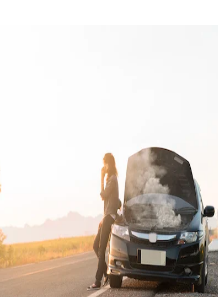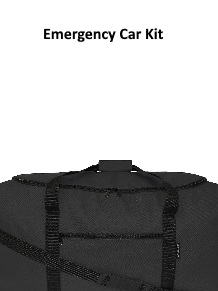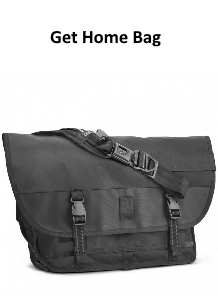Emergencies can happen anywhere.
There are 168 hours in a week. Many of us sleep for 49 + of those hours and many of us are at work, school or college for another 40 hours plus. Then there are times when we are travelling, shopping, visiting friends or family and of course carrying out pastimes and hobbies. This means we are just as likely to experience an emergency when we are away from our homes.

Our vehicles
For some our car is our second home, be it just a mode of transport to get from A-B or in some cases our mobile office. On that basis it is prudent to have a few items stored in the boot. Unfortunately it is not unknown to be stuck in traffic jams for a considerable period of time. Add to the mix weather conditions and it can be a miserable experience.
Or perhaps you have broken down and need assistance. Staying put inside your vehicle is not always the safest place to be. If you have broken down on a motorway or arterial road it is best to vacate your vehicle and await help from the safety of the verge. There are too many horror stories of people staying within their vechicle only to have another vehicle plough in to them. Often with devastating results.
Just remember, if you do vacate your vehicle then stay upstream of moving traffic. Then if another vehicle does collide with your vehicle the debris will be pushed away from your location and not in your direction.

Car Kit
Firstly you should make sure your vehicle is routinely serviced and roadworthy. You should also check fluids, lights and tyres at least on a weekly basis. Ensure that your spare wheel is correctly inflated and in good order, along with the vehicle jack and wheel brace, and that the locking wheel nut key is in the glove box. For those vehicles not fitted with a spare, make sure the emergency tyre inflation foam is in date. Where finances allow, breakdown cover should be purchased. Some insurance companies include this in their policy.
It is good practise to ensure you have a blanket, outdoor clothing (for the season), and a pair of comfortable walking shoes or boots kept in your boot or luggage compartment.
If you are confident in your ability to change bulbs and fuses then it is prudent to carry a set of spares that are applicable to your vehicle, and the tools required to effect repair.
Purchase a Res-Q-Me tool and fit it to your car keys. A Res-Q-Me tool incorporates a seat belt cutter and window breaker.
Then consider adding the following items into a holdall that will be kept in your boot.
- Emergency cash, notes and coins.
- A selection of basic hand tools.
- Head torch and spare lithium batteries.
- Hi-viz waistcoat for each occupant.
- Foil surival blankets and a few black bin liners (ground sheet).
- Gloves and a warm hat.
- 2 lires of drinking water.
- Cereal bars or other non perishable snacks.
- Tow rope.
- Assorted cable ties, Gorilla tape and some strong cord.
- Jump leads.
- SheWee or Travel John (portable urinal), toilet paper, wipes and hand sanitiser.
- Mobile phone charger.
- Paper road atlas.
- Note book and pen.
- Screen wash and de-icer depending on the season.
You might also decide that a small hexi (solid fuel) stove, a lighter, metal mug or pot and instant tea or coffee would be beneficial along with spare vehicle fuel (in an approved container), a hazard warning triangle and a snow shovel depending on your location.
Do not operate a stove within the confines of your vehicle. Fire and Carbon Monoxide poisoning risk!
Get Home Bag
A Get Home Bag is a bag (messenger or day pack), that consist of items that will aid you getting home in the event of an emergency regardless of your mode of transport. The contents will vary depending on how far you are normally away from home. If you rarely venture 5 miles from home it will contain fewer items than if you are usually 20 miles away. Suitable walking shoes or boots are essential along with appropriate outdoors clothing.
Depending on the nature of the incident you may be held within a building for an extended period of time or be forced to travel an alternative route that may be through unfamiliar areas and as a consequence add time and distance to your journey.

Contents
- Paper list of contacts, you may lose your mobile phone.
- Paper map, pocket A-Z of your area including regular routes such as to and from work.
- Spare prescribed medication(s) and a copy of your prescription.
- Spare glasses.
- Spare cash (notes and coins).
- Torch, spare batteries (Lithium last better and are less affected by temp), charger for your mobile device.
- Whistle. Uses much less energy than calling for help. You may be locked in a lift, trapped in a building etc.
- Multi-tool or Swiss Army Penknife (non locking blades and cutting edge less than 3 inches - Legal in a public place and no good reason required to carry it). Bladeless multi-tools are also available if you routinely travel on the Underground where restrictions may apply. Do not take any bladed article into a school or college!
- First Aid Kit and pain relief tablets.
- Gloves.
- Face mask.
- Packet of tissues, wet wipes and hand sanitiser.
- Females should consider a SheWee.
- Note book and pen.
- 500ml to 1litre of bottled drinking water.
- Cereal bars. (Non perishable food to tide you over).
- Foil blanket, emergency sleeping bag/bivvy bag (these are relatively cheap, have a smaller packed size than 1 litre of water and weigh next to nothing). Disposable poncho.
This list is not definitive and should be adjusted for the number of people and anticipated distance you may be required to cover. Additional water, food, suitable clothing and shelter should be considered.